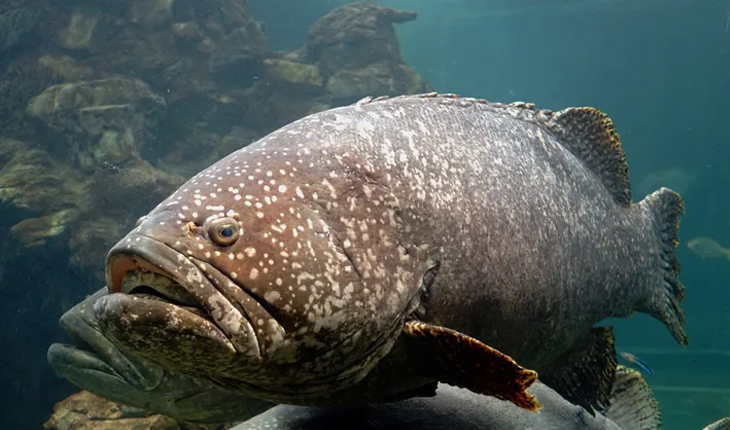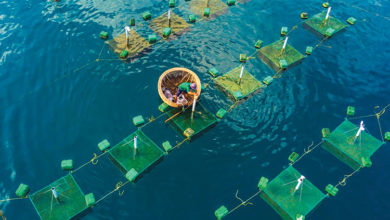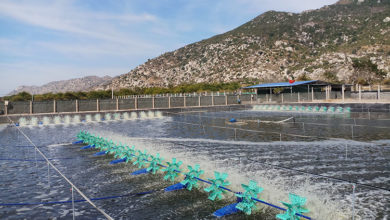The Blue Revolution and Global Shrimp
The coastal deltas of the Mississippi and Mekong rivers are vast estuaries where river and sea water mixes in a complex of marshes, swamps, and natural ridges built by river sediment over millennia. These deltas are major shrimp-producing regions for the United State and Vietnam. The similarities and differences between these two shrimping regions speak to the broad forces shaping contemporary global food systems as well as how such forces act on and are shaped by specific places.
In some ways, the Louisiana and Mekong delta shrimp industries could not be more dissimilar. While Louisianians catch shrimp from the sea, Vietnam relies primilarily on aquaculture, the growing of aquatic creatures in ponds on shore or in pens suspended in water. Louisiana’s industry involves far fewer people, is oriented to the domestic market, and has a tiny market share; the Mekong Delta’s employs many more, is export-oriented, and makes up a much larger share of Vietnam’s shrimp harvest. In Louisiana, some 5,700 shrimpers netted 63,000 metric tons from the Gulf of Mexico in 2006. Louisiana’s catch makes up more than a third of domestic shrimp production but less than 5% of U.S. shrimp consumption, 90% of which is imported and most of which is farm raised. By contrast, 300,000 shrimp farmers in the Mekong Delta grew 287,000 tons that year, or about 75% of Vietnam’s shrimp production, the vast majority of which is exported to core countries.
A commercial shrimp fishery first developed in Louisiana in the late nineteenth century to export sun-dried shrimp to Asia. Filipino and Chinese fishermen were central to the establishment of the shrimp drying industry and taught the practice to others. After World War II, frozen shrimp began to predominate in the market and shrimp prices rose markedly, tapping into the growing affluence of consumers. As people had more disposable income, they went out to eat more often, increasing demand. Louisiana shrimping developed around family ownership and operation of boats. Siblings, in-law, children, and spouses participated in catching shrimp and pooled financial resources and experience to build boats and set up relatives in the business. Communities of Cajuns, Native Americans, African Americans, Croatians, Canary Islanders, and, after 1985, Vietnamese and Cambodians have been prominent in domestic shrimping. Shrimpers run everything from 25-foot day boats that can operate for a month in the deeper waters of the Gulf of Mexico. In recent decades, the industry has seen booms and busts due to changing shrimp prices and costs of production, hurricanes, and Mississippi River floods that disrupt the season, and increasing government regulations put in place to protect endangered sea turtles and other “by catch” species other species that may be caught along with the shrimp.

But all these issues did not do as much to cripple the Louisiana shrimp industry, remarkable for its ability to bounce back from such adversity in the past, as the collapse of shrimp prices following the dramatic expansion of shrimp imports in the U.S market. Between 2000 and 2003, shrimp imports increased 46% and the domestic industry’s market share dropped from 17,6% to 11,5%. During the 2000s, Gulf of Mexico shrimp prices fell by 39%; during the same years diesel prices more than doubled. This created a cost/price squeeze, which involves the simultaneous decrease in selling prices and rise in production costs that reduce a business’s profit margin. The number of Louisiana shrimpers fell by half over the decade. Those remaining lived at a considerably reduced standard of living, intensified their fishing effort, targeted larger, more expensive shrimp to retail to consumers, diversified into other businesses, or replaced hired deckhands with unpaid family members.
The cost/price squeeze made it more difficult for shrimpers to recover from hurricanes in 2005 and 2008 and the 2010 oil spill because it slashed the income they had to sustain themselves and rebuild from these disasters. While in the short term many Louisiana fishermen have been able to sustain their families, the intergenerational continuity of the industry is being broken as young people seek better and more stable work and their parents discourage them from following their ancestors into shrimping.
The changes in Louisiana are largely the result of the proliferation of shrimp aquaculture, which was responsible for just 5 percent of the global shrimp supply in 1980 but had increased to 52 percent in 2008. A “Blue Revolution” in world fisheries that in turn expanded aquaculture in the late twentieth century. Alongside the Green Revolution, which transformed agriculture in many parts of the periphery, the Blue Revolution has shifted primary-sector activities toward a greater dependence on capitalized inputs-credit, machinery, fuel, feeds, fertilizes, and pesticides-instead of human labor and natural productivity. On the one hand, the Blue and Green revolutions have increased food production in many places, but on the other they have engendered conflict over how the new practices redistribute power and wealth.
Aquaculture has a prominent place in the Blue Revolution. Advances in farming species like carp and tilapia in countries like China have increased the availability of fish for millions of people, yea to date aquaculture has found its greatest economic success in catering to the demand of affluent consumers in the core for products like shrimp and salmon. The major consumers of farmed shrimp are Japan, the United States, and the European Union, while the largest exporters are Thailand, India, Indonesia, Vietnam, and Mexico. Shrimp is big business, the most consumed seafood in the United States and a source of billions of dollars in exports for peripheral countries.
The global shrimp industry is also a major source of controversy; coastal residents in some exporting nations denounce shrimp farming for destroying wetlands; damaging nearby agriculture with salt water; seizing land, water, and access to the sea from communities; and causing violent conflicts between shrimp farmers and their neighbors. The so-called “Pink Gold Rush” of shrimp exports has come with a high social and ecological cost. Globalizing shrimp has also created new economic hazards for shrimp producers themselves.
In Vietnam, the modern shrimp industry is much younger than Louisiana’s. Most Mekong Delta shrimp farmers grew rice before 2000, after decades of hard work converting saline coastal wetlands into freshwater environments where rice, fruit, and fish were grown for subsistence and domestic markets. By the late 1990s, Vietnam had achieved self-sufficiency in food grains and the national government pursued an export-oriented economic development strategy, allowing farmers to shift away from rice towards more profitable crops. At this time, very low rice prices coincides with exceptionally high shrimp prices. This price ratio encourage farmers to convert some 280,000 hectares of coastal rice land to shrimp, a saltwater crop, in the early 2000s just as global farmed shrimp production surged and prices began their dramatic downward slide. As in Louisiana, family farmers make up the vast majority of shrimp producers in the Mekong Delta, relying on unpaid household labor and limited credit to operate their small farms. Initially, Vietnamese farmers achieved good incomes from shrimp, but disease problems plagued shrimp farming, harming productivity and pushing some out of business. Even many successful farmers’ debts grew rapidly to finance intensification.
By the late 2000s, as shrimp prices continued to fall, the cost of fertilizers and chemicals rose with the price of oil. Rice prices skyrocketed, profits from shrimp declined and many producers wanted to go back to rice cultivation. Some areas adopted rice-shrimp farming in rotation, growing shrimp during the saline dry season and rice in the rainy season, but for most farmers in the coastal Mekong Delta the increase of salts in the soil (salinization) and the decay water control infrastructures meant rice could no longer survive in their fields. Most producers could not reverse course and became effectively “stuck” with shrimp for the foreseeable future even though the price trends that pushed them towards aquaculture had reversed.
For both Louisiana and Mekong Delta shrimp producers, the 2000s have been a decade of profound and often difficult change. Small family producers in both regions sell shrimp to a global market characterized by price volatility that has squeezed their margins while expanding the supply of cheap shrimp for consumers and the major corporations that export, import, and wholesale seafood. While they face common challenges due to globalization, shrimpers in the United States and Vietnam have been effected by the challenges in different ways and have pursued varied coping strategies. A policy for their mutual benefit could include higher and more stable international shrimp prices global seafood industry.
Ph. D Brian J Mark
Dept. of Geography and Anthropology
Louisiana State University






